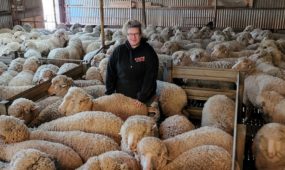Seed Terminator says hasta la vista to weeds
Primary Industries
A MACHINE that pulverises weed seeds as grain crops are harvested has begun commercial manufacture in Australia.

Sign up to receive notifications about new stories in this category.
Thank you for subscribing to story notifications.
Invented in South Australia, the Seed Terminator can be retrofitted to new and used John Deere, CASE IH and New Holland Class 7, 8 and 9 harvesters and will retail for under AU$100,000.
The Seed Terminator uses a multi-stage hammer mill to kill weed seeds, spreading the sawdust-like debris behind the header.
Nine prototypes were built and tested across nine different geographies in South Australia, Western Australia, New South Wales and Victoria with different crop types, soil types and moisture contents during the recent 2016/17 harvest.
Tests by the University of Adelaide’s Weed Science Research Group from last year showed a greater than 90 per cent kill of rye grass seeds using the machine at 2700 RPM.
Seed Terminator inventor and Kangaroo Island farmer Nick Berry and his business partner Mark Ashenden are also developing prototypes for the North American market that they hope to test in the 2017 northern hemisphere harvest.
The team is working with a company in South Australia’s capital Adelaide to manufacture the mill while the drive system is being built in Western Australia.
They have received more than 90 expressions of interest to buy one of the 2017 limited release Seed Terminators in time for the next Australian harvest. The machines will be available from September.
Ashenden, the company’s commercial director, said the Seed Terminator was a “colour-blind solution” that could be fitted to major header brands including John Deere (green), CASE (red) and New Holland (yellow).
He said the key to cost saving was the development of their patent pending mechanical drive paving the way for commercialisation.
“The design of the mill to effectively kill the seeds is the critical piece – it requires a purpose built mill and a purpose built drive to match whatever colour machine you want to put it on,” Ashenden said.
“We’ve already attracted interest from Canada, the United States and Europe … wherever grain is grown, this could be part of the answer.”
Farmers involved in the prototype testing were given the option to purchase their machine and all were sold.
The 2016/17 prototype trials were conducted on John Deere (STS9760, 2xS680), CASE IH (7120, 8010, 8120, and 9240) and New Holland (CR8090) headers. The 2017 harvest program will also include a prototype fitted to Claas Lexion harvester to increase farmers’ options.
“It worked everywhere across the country and while there were drive system challenges that were overcome critically the multi stage hammer mills didn’t miss a beat,” Ashenden said.
Domestic manufacturing targets north of 100 machines have been set for 2018, depending on demand.
Ashenden said there were about 15 key grain-growing regions in Australia and he hoped to have at least one Seed Terminator operating in each area during the 2017/18 harvest.
“Australia is about 3 per cent of world grain supply so in this sort of space there are tens of thousands of units per annum in North America that this technology could be fitted to,” he said.
“We’d like to think we could build it and prove it here and manufacture it for export. “
Berry and Ashenden have been awarded a $300,000 Accelerating Commercialisation Grant from the Australian Government to fast-track production.
Ashenden said the “one-pass solution” pulverised seeds and spread the nutrient rich debris 10-12 metres either side behind the harvester to act as a fine mulch for soil improvement.
He said it would likely result in increased yields because there would be significantly fewer weeds to compete with crops for nutrients.
“It should reduce fertiliser costs, could reduce chemical costs but will significantly reduce your time because you don’t have to go around collecting it to burn,” he said.
“The Seed Terminator ticks all the environmental boxes – it can’t be a bad thing to reduce chemicals, reduce burning and reduce costs for a farmer.
“It’s not the Holy Grail but it’s a pretty strong part of the solution.”
The Grains Research and Development Corporation (GRDC) estimated in 2016 that weeds cost Australian grain growers about $3.3 billion annually, with yield losses of 2.76 million tonnes. The GRDC also estimated herbicide resistance costs farmers $187 million a year for herbicide treatment and other weed management practices.
Jump to next article



